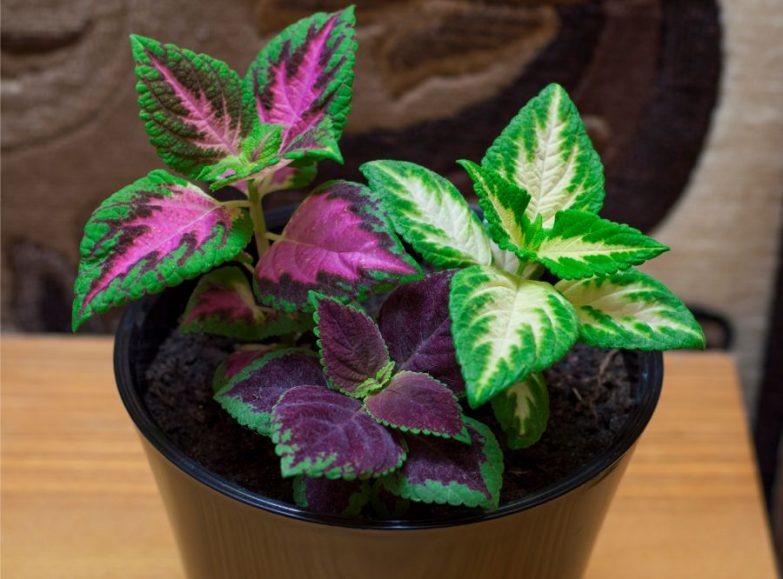Most of us know beautiful coleus plants as gorgeous additions to border plantings in gardens or bright pops of color in containers, but did you know that actually make great indoor plants as well? This article will tell you all you need to know about coleus plant care indoors, so you can brighten your indoor space with their stunning foliage.
Coleus plant care indoors: Provide bright indirect sunlight, temperatures of 65-75°F, and moderate to high humidity levels. Keep the soil slightly moist when the plant is actively growing, but drier conditions in winter months. Fertilize lightly with a high nitrogen fertilizer every two weeks, and pinch back the stems to create a fuller, bushy plant.
Coleus is an easy to grow plant and will thrive indoors if cared for properly. The following information covers all of the different aspects of caring for this beautiful houseplant.
Coleus Plant Overview
Also known as Painted Nettle, coleus (Solenostemon scutellarioides) is a member of the mint family and is native to Southeast Asia. Surprising to most people, it is technically an evergreen perennial that is primarily grown as an annual because of its sensitivity to frost.
Because of their predisposition for warm climates, they make great indoor houseplants.
Coleus Plant Indoor Care Summary
| Scientific Name | Solenostemon scutellarioides |
| Origin | Africa, Asia and Australia. Many cultivars grown for colorful foliage. |
| Light Requirements | Bright, indirect light. Some direct morning sun is ok. |
| Watering | Maintain lightly moist soil during the growing season. Allow top few inches to dry between watering in winter. |
| Soil | Rapidly draining potting mix. Most general purpose potting mixes work well. |
| Temperature | 65°F-75ºF (24C°-27ºC). Very intolerant of cold and frost. |
| Fertilizer | Half strength fertilizer applied every two weeks during the growing season. High nitrogen preparations are best to promote foliage and suppress flowering. |
| Humidity | Medium to high humidity. |
| Flowering | Tiny white or bluish flowers. Pinch off buds promptly to prevent flowering, or plant will go to seed and die. |
| Pruning | Pinch back growing stems to maintain compact growth. |
| Propagation | Stem cuttings can be propagated easily. |
| Re-Potting | Repot every 1-2 years. Increase pot size only if a larger plant is desired. |
| Diseases and Pests | Fairly resistant, but root rot, mold, mildew, aphids, spider mites and mealybugs can cause problems. |
| Toxicity | Toxic to pets and mildly toxic to humans. |
| Where To Buy | Buy Coleus online at Etsy (I buy most of my houseplants from Etsy). |
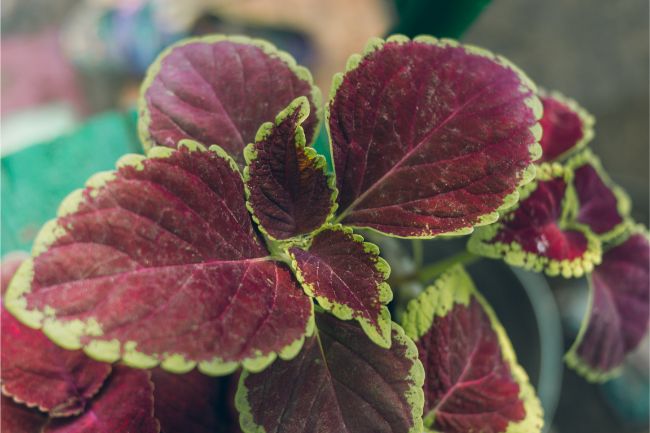
Characteristics Of Coleus Plants
- Grows from 6-inches to 3 ½ feet in height depending on the variety.
- Plants grow 1 to 3-feet wide.
- Leaves range from one to six inches long.
- It can grow upright or trailing, depending on the variety chosen.
Guide To Coleus Plant Care Indoors
Coleus have gained their popularity as beautiful garden and landscape plants, but they are grown as annuals in all growing zones except USDA hardiness zone 11 because they are incredibly intolerant of frost and cold temperatures. Because of this, they are gaining popularity as indoor-grown container plants.
When growing plants in your home, provide the following growing conditions to promote strong, healthy plants.
Light Requirements
When grown indoors coleus prefers bright, indirect light. It’s best if they can live on a windowsill that gets light in the morning or early hours of the day and has shade during the most intense sun exposure in the late afternoon.
Some direct sun is okay, except intense summer sun which will scorch the leaves or cause the bright colors to fade. Too little light dulls leaf colors and may cause leaves to drop.
You may need to supplement available light with artificial lights during the winter. Watch the plant closely. If the leaves fade and lose color, the plant is probably getting too much sunlight. However, if the plant is lackluster and drops its leaves, try giving it a little more light.
Coleus Plant Temperature Range
Tropical houseplants do well indoors because they prefer the same temperature range as we humans do. For best growth keep your plants in a room where temperatures are between 65°F-75ºF (24C°-27ºC) or even up to 85ºF, avoiding any sudden drops in temperature.
Keep your plants in a spot where they are not exposed to drafts coming from leaky windows, opening/closing doors, or register vents blowing heat in the winter and cool air in the summertime.
Humidity
Coleus prefer environments with medium to high humidity levels. For most homeowners, low indoor humidity makes coleus plant care indoors a little more challenging than outdoor care. You’ll need to create a pocket of moist air for your coleus plants to really help them thrive.
If your plants begin to show brown tips or crispy edges, signs your air is too dry, you can increase the humidity level by grouping plants together, or setting your plant in a tray containing pebbles and water.
Don’t mist the leaves like you would with other tropical plants to avoid creating water spots on the velvety foliage.
Read this article for my best tips for increasing humidity for your houseplants.
Soil For Coleus Plant Care Indoors
Coleus plants prefer a soil that drains quickly and provides good aeration to the roots. Due to this most “all-purpose” commercial potting soils are suitable. Avoid anything specifically formulated for a given plant type such as acid-loving plants or succulents.
Commercial potting soils are actually a “soilless” mix of peat moss, coconut coir, pine bark, and either perlite or vermiculite. Avoid using straight coconut coir or sphagnum peat moss in your containers; they retain too much water. To improve the drainage rate of the potting soil you can add extra perlite.
Read my complete guide to choosing soil for your houseplants. This covers everything you need to ensure your plants are always in the best soil to help them thrive.
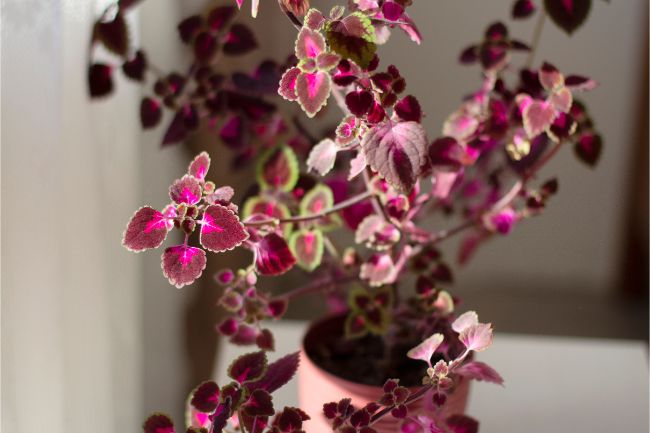
Watering
During the active growing season in the spring and summer keep the potting soil slightly moist, although not soggy, at all times. Coleus plants do best if the soil isn’t dry or overly wet.
During the winter when growth is slower, scale back slightly on watering. Allow the top ½ inch or so of potting soil to dry out completely before you give your plants a drink.
Water with tepid water and avoid getting water on the velvety leaves. Hard water will leave water spots that are nearly impossible to remove.
If you live in an urban or suburban area with treated water it is best the water is allowed to sit for a couple of days before using it to allow the chlorine to dissipate. This helps to lower the risk of chlorine toxicity in your plants.
Read my article about how to water your houseplants to prevent over- and under-watering.
Fertilizer
Fertilize every 1 to 2 weeks during the active growing season at about half the strength recommended on the fertilizer label. Do not fertilize when the plant isn’t actively growing during the colder winter months.
To promote good foliage growth and minimize flowering you will want to purchase a quality fertilizer that is higher in nitrogen and lower in phosphorus.
Avoid a balanced fertilizer that has an equal ratio of N-P-K such as a common 10-10-10 formulation. Look for a water-soluble or liquid all-purpose plant food and mix it at half the strength of the recommended dosage on the label or even slightly more diluted.
Flowering
Coleus will flower in the summer with racemes of tiny white or bluish flowers if given the correct care, but unfortunately, you should prevent flowering if you want to keep your plants around.
If your plants do flower make sure to pinch the flower buds off immediately. Flowering triggers your plant into thinking it needs to go to seed. Once it goes to seed, it dies. So, keep pinching off the flower buds as they form to extend the life of your plant.
As a side note, plants that have been propagated from stem cuttings typically won’t flower as often, if they do at all.
Pruning
Pinch back the stems of your coleus to keep the plant from getting too leggy. This triggers growth from growing points at the nodes on the stem, creating a fuller, bushier plant.
You can pinch the stems back at any time but it’s best to do it when the plant is actively growing during the warmer months. When you pinch them, make sure to cut the stem cleanly immediately after a leaf node using either your fingernails or a sharp pair of clean scissors.
Propagation
In spring or early summer remove a 3 to 4-inch long stem tip cutting that has at least 3 leaves attached to the end piece. Cut just below a leaf node where a leaf is attached to the stem. You can then place the cutting in a jar or glass with clean water until roots form or immediately put it in a small container with moist potting soil.
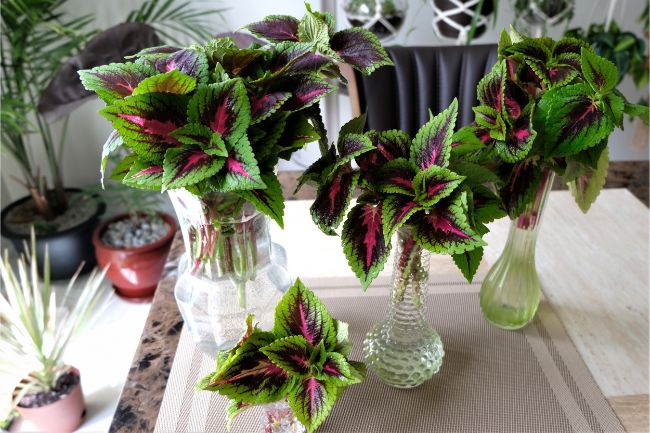
Re-Potting
Over time your coleus may outgrow the container you have it growing in, and need to be moved to a bigger one. A plant that is root-bound in a container will have slower growth or the growth may be completely halted.
If you don’t want your plant to get any larger it’s acceptable to keep it in the current pot, but you can remove it and add new potting soil every year or so.
If you want it to grow more it’s best to repot it, putting it in a container that is 1 to 2-inches wider in diameter and about the same increase in container height. When repotting gently tease the roots with your fingers to loosen them up and then add fresh potting mix.
Springtime is the best time to repot plants as they begin actively growing after the cooler winter months, and can bounce back from the shock of repotting quicker.
An important note – when filling containers with growing media do not create a “drainage layer” in the bottom of the pot. For a long time, this was a highly recommended practice, taught to new gardeners. It’s been proven though that this practice is more detrimental than helpful.
As water moves down through the soil profile via gravity, it stops when it encounters this drainage layer created by rocks or small stones. Before the water percolates into the layer, the entire potting soil must fill with water rendering the layer problematic instead of beneficial.
Diseases And Pests
Coleus plant care indoors is thankfully not troubled too much with disease and pest problems, although they do exist, unfortunately. One of the biggest culprits of both is overwatering so watering plants only when they need it will help prevent problems.
Monitor your plants frequently to catch problems early and treat them before damage is extensive.
Diseases
Like most other potted plants, coleus is susceptible to root rot if overwatered. Plants will also occasionally have problems with downy mildew or powdery mildew.
Root Rot
The most commonly seen problem with coleus is root rot, caused by overwatering, especially in the winter months. The roots then die back due to lack of oxygen or the overgrowth of a soil fungus. Soggy soils encourage the growth and multiplication of Pythium, Phytophthora, Rhizoctonia, or Fusarium fungi which spreads into the roots, infecting plants.
Healthy roots begin to turn brown and mushy as they perish, unable to take in nutrients needed for growth. As root rot progresses leaves turn yellow, wilt, or droop and then become mushy as well. Once symptoms are visible in the leaves the problem may be past the point of rectifying, endangering the entire plant.
If caught soon enough you can repot the plant, to try to save it. Remove as much of the infected soil as possible adding in fresh, clean potting soil. If root rot has spread significantly, dissect the plant, keeping only the healthy portions. If the whole base is affected, take stem cuttings from healthy foliage to propagate a new plant.
Read my article on how to identify, fix and prevent root rot for more info.
Downy Mildew
This fungal disease occurs on the top of the coleus leaves in humid weather conditions. When infected, foliar symptoms include chlorosis, angular lesions, distortion (leaf curling), and leaf drop. Lower leaves are affected first and may develop as a downy gray to purplish growth on leaf undersides.
Remove any infected or diseased plant tissue using sterilized scissors or a razor blade. Dispose of tissue in the trash. Consider treating with an appropriate fungicide. If the disease is severe it may be best to dispose of the entire plant.
To prevent downy mildew, water at the soil level to prevent spores from splashing up onto foliage or neighboring plants.
Powdery Mildew
Powdery mildew presents as a white powdery film on the leaves and stems of your plants. It looks similar in nature to a dusting of flour. Over time it may darken in appearance to a grey color and may spread down to the soil. Powdery mildew impairs photosynthesis since it covers the leaves. This causes a stunting of the plant’s growth and can kill the plant if left untreated.
Remove any infected or diseased plant tissue using sterilized scissors or a razor blade. Dispose of tissue in the trash.
It is typically recommended that you spray infected plants with bicarbonate solution or a sulfur-based fungicide according to the label directions but this should be avoided with the coleus’ velvety leaves.
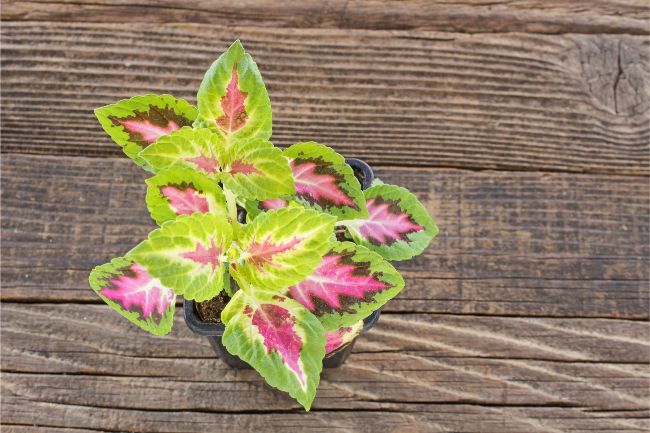
Insect Pests
Insect problems are going to be your biggest challenge with coleus plant care indoors, mainly if you have neighboring houseplants with aphids, spider mites, or mealybugs.
Aphids
Aphids are one of the most common insects affecting indoor plants. These tiny, pear-shaped insects attach themselves to the plant, sucking sap from the plant tissues, and then secreting “honeydew”. Symptoms appear as distorted foliage and leaf drop.
Remove aphids by wiping the plants with a clean, soft cloth or spraying the plants with a mild solution of water containing a few drops of dish soap.
Spider mites
These tiny sucking pests are found on the undersides of leaves, wreaking havoc on indoor houseplants. Spider mites feed on the fluids found inside the leaves of coleus, piercing the waxy coating to access the internal fluids.
One of the biggest challenges with spider mites is their prolific nature; oftentimes a heavy infestation will occur, unnoticed, before plants begin to show physical symptoms of damage.
With an infestation of spider mites, leaves may be stippled with discoloration or turning yellow overall. Plants may also exhibit a fine, spider-like webbing between the leaves or at the base of the plant.
Read my article about getting rid of spider mites to deal with these suckers.
Mealybugs
These pink, soft-bodied insects are covered with a white, waxy, almost cottony-like material. The cottony fluff protects them from moisture loss and excess heat. Mealybugs are usually found in colonies in somewhat protected areas of the coleus such as where the leaves attach to the stems.
Symptoms show as stunted or deformed leaf growth, especially on new foliage as mealybugs inject a toxin into leaves when they feed on the plant’s fluid. They also excrete honeydew as they feed, encouraging the growth of sooty mold
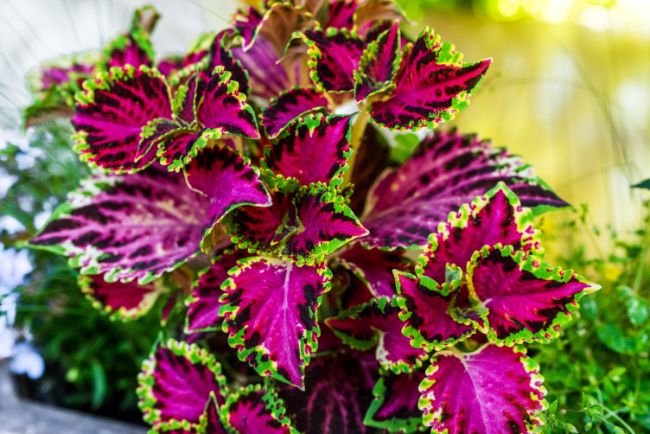
Toxicity
This is the one drawback to coleus plants: they are dangerous to pets and can trigger mild skin reactions in some people. The essential oils found in the plant’s foliage are toxic to dogs, cats, and other animals. For people with skin sensitivities, they can also cause contact dermatitis or other irritations.
If you do have pets keep your coleus out of their reach if possible. If you’re looking for alternate pet-safe houseplants, take a look at some of my favorites in this article.
Varieties
Boundless varieties of coleus, literally hundreds of different ones, are available. Foliage colors include red, maroon, brown, cream, yellow, orange and green in an array of dramatic combinations and designs. Leaf edges may be scalloped or ruffled and have a contrasting color.
Some of the most popular varieties include:
- Kong Series are some of the best to grow indoors as they prefer filtered shade; large leaves grow up to 6-inches wide and have dramatic markings.
- Wizard Series grow 12 to 14-inches tall and have a branching stature.
- Superfine Rainbow Series have large, vibrant multicolored leaves, and grow bushy up to 15-inches tall.
- Giant Exhibition Series grow up to 20-inches tall with large (6 to 7-inch long) leaves.
- Premium Sun Series are vigorous, mounding, and well-branched, making them great for small spaces and garden borders.
- Fairway Series are super showy and extra dwarf, growing only 8 to 10-inches tall.
Problems With Coleus Plant Care Indoors
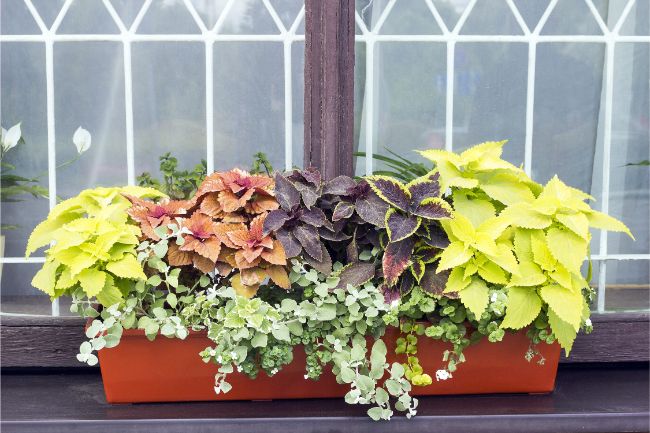
Why are my coleus leaves curling?
Curling leaves is a common issue with coleus plant care indoors more than outdoor care. Common causes are downy mildew or other diseases. Low humidity, underwatering and temperatures stress can also cause leaf curling.
Curling leaves is a sign that something is not quite right with your plant and you should look closely for any problems. Go through the care summary at the top of this article and check you are meeting all of the basic care needs for your coleus.
Why is my coleus drooping?
Your coleus may be drooping because of improper watering. Leaves will droop if plants are underwatered and they are drought-stressed, or if the plant was over-watered and is experiencing root rot.

